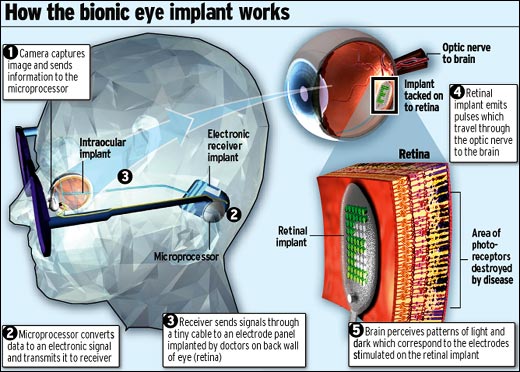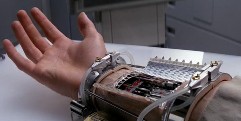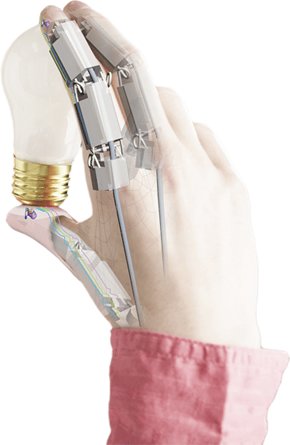How close are we to real-world bionic parts like they show on TV? We spent Part I discussing Bionic Women on TV and speculating as to why they spent $55 Million on Jaime Sommers in the show but couldn't fix actress Michelle Ryan's chin.
Now we're going to get into actual science, like how we would build a Bionic Woman today if we didn't give a crap about television ratings. It's a good thing I am writing this now because television ratings are important and this show could be cancelled any day, making it a lot less culturally relevant. How will I get you to buy a book on science if it doesn't have pop culture relevance and cute girls?
So in our analysis of the Bionic Woman we have to start with the eyes because it's the first real piece of marketing they did and it was quite good.

A bionic eye is a little clunky but looks quite promising. In this retinal implant, a tiny external camera sends images to a microprocessor which processes them and sends them to an electrode panel placed on the back of the retina. In the first clinical trial, patients with the implants could detect light and motion and even identify some objects.
This has nothing to do with perception, like how Michelle can take photos like this ...

Yayyyyy!

... but will instead be images and won't determine for patients with macular degeneration why physical scientists are sexier than mathematicians.

Next we have bionic arms. There's no point to having bionic parts unless you can do feats of super strength, right?
Well, it might be nice to be able to pick up a gallon of milk or move a box if you can't do those things now so let's assume that covert paramilitary organizations bent on saving us from world domination are already overstocked with super-powered help and you would just like to be able to do normal tedious stuff. DARPA is funding a rocket-powered solution. A group of mechanical engineers at Vanderbilt have developed a prototype that moves at the wrists and can manipulate fingers and thumbs independently - a total bionic leap over current models that are basically an elbow and a claw.
They also have the power supply down to about the size of a pencil and their arm can curl about 25 pounds - not quite enough to bend steel but enough to do almost anything a normal person would want.

Occasionally you'll need to run from a disgruntled husband or a horde of spurned supermodels. If this were television, that would mean rather fake looking leaps over huge chasms, mostly because Hollywood can not figure out that people do not strike a pose and jump. In real life it would just be walking yet that is still enough to get us thinking about bionic legs.
Anything that gives people more mobility is good so it's difficult to call any aspect of bionics the 'weakest' but, if we compare fairly, legs are the least far along. The majority of leg issues, though, are below the knee rather than the entire leg and there is a terrific advancement in 'smart' below the knee prosthetics. This transtibial device has enhanced ankle motion and push-off power comparable to the gait of an able-bodied individual - pretty darn slick. Video of other below the knee prosthetics below:
Still, if we want to stay in our bionic super-strength motif it might be better to just strap on an entire exoskeleton.
Nothing says 'bionic parts' on a date like having a big mechanical hand crushing metal wine goblets (saying "Groovy!" is also a nice touch) but sometimes you want to be more gentle. Science is helping there also with artificial skin that feels heat, touch and cold.

The next step after realistic skin will, of course, be soft-bodied robots. I can't imagine what Japanese people will think to do with those.
Last, but not least, is the bionic ear. Sure, you could always stalk her and hack into her email to find out if she's stringing along other bionic conquests, but super-hearing makes it so much easier. So far this only works on people with von Hippel-Lindau disease, which is caused by inheritance of a mutated tumor suppressor gene and occurs in 1 out of 36,000 live births. So it needs some work.
Are there even more bionic devices in the works? Sure. We just covered the Bionic Woman here but if you are interested in a bionic anus or a bionic tongue or even a bionic stomach for that chili pepper festival, you now know where to look.
With your keener understanding of the technology behind all of this, you can give the Bionic Woman TV show a try with newfound insight. TV needs more science fiction shows but even if it doesn't work out, Ryan was in Cashback




Comments